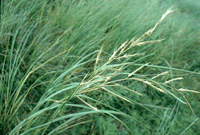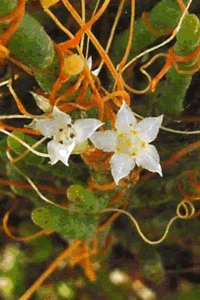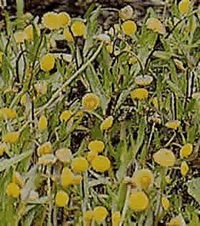Cordgrass
Spartina foliousa

This plant forms the lower edge of the salt marsh in San Francisco Bay, near mean sea level, and appears to be the only plant (other than marine algae) that can successfully tolerate alternate exposure and flooding of saltwater. Cordgrass grows to four or more feet high. During high tide when the cordgrass is mostly underwater, oxygen is passed down to the roots from the leaves via hallow tubes in the stem and rhizomes, enabling the roots to survive. It tolerates the high salt content of the Bay by exerting unneeded salt through salt glands in the leaves.
Cordgrass is known for its high productivity whereby it produces tremendous amounts of organic material every year called detritus. Detritus forms the basis of the food web that many animals are dependent upon, including: clams, oysters, shrimps, crabs, fish, waterbirds, and even man.
Pickleweed
Salicornia

One of the more common and unusual looking plants of the salt marsh is the pickleweed or grasswort. It has no leaves and thus photosynthesis occurs in the jade grass stems. (Some feet that the stems are, in fact, the leaves, however greatly modified). Unlike cordgrass and saltgrass, pickleweed does not excrete the excess accumulated salt through special glands. Instead, it concentrates the salt in its joints, succulent stems and by autumn, the ends of the stems turn pink to iridescent red, dry up and eventually break off; thereby ridding itself of the excess salt. The pickleweed has tiny yellow flowers that appear on the stem in summer with male and female flowers on separate plants. In some areas of San Francisco Bay the pickleweed provides habitat for the salt marsh harvest mouse and clapper rail, two endangered species.
Salt Marsh Dooder
Cuscuta salina

During the summer, mats of tangled orange threads on pickleweeds, gum plants and other high marsh plants can be readily seen. These orange threads are actually a parasitic plant called the marsh dodder that lacks chlorophyll. The germinated seeds initially develop into free-living (non-parasitic) young plants, green with chlorophyll. Once the youngdodder reaches a host plant, such as a pickleweed, it sends roots into the host and the original roots and stems die. The dodder then loses most of its green color and develops orange threads and tiny white flowers, securing its nutrients from its host.
Saltgrass
Distichlis spicata

Saltgrass is quite common and often occurs in dense mats, 8-12” tall, in the high marsh area. It has many distinct narrow, pointed blades that alternate up the stem. The stiff blades typically are overladen with salt crystals, which are excreted by special salt glands on the blades. Often, it is found together with pickleweed and other salt marsh plants, andlike the pickleweed, male and female flowers occur on different plants (diocious) during late spring to summer.
Alkali bulrush
Scirpus robustus

The alkali bulrush is typically found in brackish marshes and its seeds have high food value for waterfowl. Its stem, like many sedges, is triangular and has alternate slender leaves growing on it. The florets are red-brown and clustered at the top of the stem with smaller leaves (typically three to four) coming out from the base of the florets. It blooms from late spring through the summer, and can grow five feet tall.
Brass button
Cotula coronopifolia

This low-lying herb is particularly abundant in brakckish marshes and is an important food plant for waterflow. Its common name, bass button, is attributed to its brassy yellow flower. The flowers bloom during the summer into winter and resemble daisy centers without rays. Its succulent stem have alternate leaves.
Jaumea
Jaumea carnosa

Superficially, Jaumea looks like pickleweed because it is low-lying and has succulent parts. Unlike pickleweed, Jaumea has succulent leaves (the pickleweed is leafless but has succulent stems). It is not as common as pickleweed in the Bay marshes.
Sea lavender
Limonium californicum

used with permission of www.laspilitas.com
Relatively uncommon in the San Francisco Bay, the sea lavender (also called the marsh rosemary) is a distinctive high marsh plant. When in bloom during summer through early winter, it has delicate lavender or violet, five-petaled flower borne on lacy branches. The winter, it has delicate lavender or violet, five-petaled flower borne on lacy branches. The stems are leafless but it does have broad, leathery green leaves that grow at the base of the plant. The lower portion of the stem is reddish. Sea lavender grow to about 24 inches high. Since it occurs in the high marsh area, it is often found associated with saltgrass.